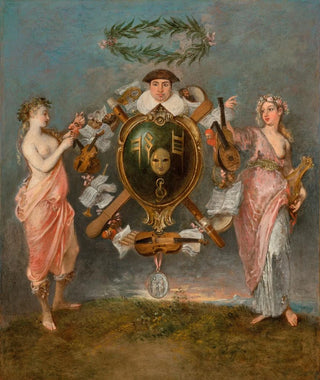Art print | L'Union de la musique et de la comédie - Jean-Antoine Watteau


View from behind

Frame (optional)
In the enchanting universe of the 18th century, the artwork "L'Union de la musique et de la comédie" by Jean-Antoine Watteau stands out for its delicate atmosphere and exploration of themes of celebration and music. This canvas, a true ode to the art of living, invites viewers to immerse themselves in a world where lightness and beauty meet. Watteau, master of rococo, manages to capture the very essence of joy and harmony through his elegant characters and shimmering colors. The art print of this iconic piece allows for rediscovering a moment of grace and poetry, while also demonstrating the lasting impact of art on our contemporary sensibility.
Style and uniqueness of the work
Watteau's work is characterized by a subtle use of light and a pastel color palette that evoke the softness of fleeting moments. In "L'Union de la musique et de la comédie," the figures, dressed in refined costumes, seem to dance in an atmosphere of conviviality and lightness. The meticulous details, such as musical instruments and the draped clothing, testify to remarkable technical mastery. This piece also stands out for its narrative approach, where each character tells a story, creating a visual dialogue that engages the viewer. The composition, carefully balanced, guides the eye across the painting, inviting prolonged contemplation of this suspended moment in time.
The artist and his influence
Jean-Antoine Watteau, born in 1684, is often regarded as one of the pioneers of rococo, an artistic style that celebrates elegance and the frivolity of aristocratic life. His ability to fuse genre painting with theatrical scene elements influenced many artists, both of his time and subsequent generations. Watteau captured the spirit of an era where music and comedy were at the heart of entertainment, reflecting the aspirations and desires of society. His innovative approach paved the way for artists such as François Boucher and Jean-Baptiste-Siméon Chardin, who

Matte finish

View from behind

Frame (optional)
In the enchanting universe of the 18th century, the artwork "L'Union de la musique et de la comédie" by Jean-Antoine Watteau stands out for its delicate atmosphere and exploration of themes of celebration and music. This canvas, a true ode to the art of living, invites viewers to immerse themselves in a world where lightness and beauty meet. Watteau, master of rococo, manages to capture the very essence of joy and harmony through his elegant characters and shimmering colors. The art print of this iconic piece allows for rediscovering a moment of grace and poetry, while also demonstrating the lasting impact of art on our contemporary sensibility.
Style and uniqueness of the work
Watteau's work is characterized by a subtle use of light and a pastel color palette that evoke the softness of fleeting moments. In "L'Union de la musique et de la comédie," the figures, dressed in refined costumes, seem to dance in an atmosphere of conviviality and lightness. The meticulous details, such as musical instruments and the draped clothing, testify to remarkable technical mastery. This piece also stands out for its narrative approach, where each character tells a story, creating a visual dialogue that engages the viewer. The composition, carefully balanced, guides the eye across the painting, inviting prolonged contemplation of this suspended moment in time.
The artist and his influence
Jean-Antoine Watteau, born in 1684, is often regarded as one of the pioneers of rococo, an artistic style that celebrates elegance and the frivolity of aristocratic life. His ability to fuse genre painting with theatrical scene elements influenced many artists, both of his time and subsequent generations. Watteau captured the spirit of an era where music and comedy were at the heart of entertainment, reflecting the aspirations and desires of society. His innovative approach paved the way for artists such as François Boucher and Jean-Baptiste-Siméon Chardin, who






